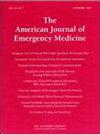苯二氮卓类药物难治性癫痫持续状态:叙述性回顾
IF 2.2
3区 医学
Q1 EMERGENCY MEDICINE
引用次数: 0
摘要
癫痫发作是急诊科常见的主诉,癫痫持续状态(SE)与显著的发病率和死亡率相关。虽然癫痫发作的典型一线治疗包括苯二氮卓类药物,但SE患者可能对苯二氮卓类药物难治。持续时间越长,癫痫发作越难打破,癫痫发作成为一个自我维持的循环;因此,苯二氮卓类难治性SE是急诊临床医生面临的一个特别具有挑战性的疾病。目的:本综述对SE难治性一线治疗进行了重点评价,强调了潜在的潜在原因和管理策略。急诊科22%的癫痫发作病例可能发生se,其中高达40%的患者癫痫发作活动对苯二氮卓类药物治疗难治性。长时间的癫痫发作活动与长期的神经系统后果有关。SE的潜在病因包括内分泌、代谢、感染、神经、产科、毒理学和创伤性病因。扭转这些潜在的原因可以帮助终止癫痫发作。苯二氮卓类药物(劳拉西泮、地西泮和咪达唑仑)被认为是一线抗癫痫药物(ASMs),必须给予足够剂量以达到其最大治疗潜力。继续发作的患者应在5分钟时接受第二剂量的苯二氮卓类药物,并联合二线ASM,如磷苯妥英(优于苯妥英)、左乙拉西坦或丙戊酸。继续癫痫发作的患者被认为是难治性SE,应接受三线药物治疗,如氯胺酮、戊巴比妥、异丙酚或硫喷妥,同时临床医生准备插管。当从二线asm转移到三线asm或需要插管时,应考虑连续脑电图(EEG)。早期积极治疗是终止癫痫发作的关键。结论早期识别和治疗SE对保留神经功能至关重要。急诊临床医生必须准备好逆转SE的潜在原因,并在必要时利用二线和三线asm中止癫痫发作活动。本文章由计算机程序翻译,如有差异,请以英文原文为准。
Benzodiazepine-refractory status epilepticus: A narrative review
Introduction
Seizures are a common complaint in the emergency department, with status epilepticus (SE) associated with significant morbidity and mortality. While the typical first-line therapy for seizures includes benzodiazepines, patients with SE may be refractory to benzodiazepines. Seizures of longer duration are harder to break, and SE becomes a self-sustaining cycle; thus, benzodiazepine-refractory SE is a particularly challenging condition facing emergency clinicians.
Objectives
This narrative review provides a focused evaluation of SE refractory to first-line therapy, highlighting potential underlying causes and management strategies.
Discussion
SE may occur in 22 % of seizure cases presenting to the emergency department, and up to 40 % of these patients will have seizure activity refractory to benzodiazepine therapy. Prolonged seizure activity is associated with long-term neurologic consequences. Potential underlying causes of SE include endocrine, metabolic, infectious, neurologic, obstetric, toxicologic, and traumatic etiologies. Reversing these underlying causes can help terminate seizure activity. Benzodiazepines (lorazepam, diazepam, and midazolam) are considered first-line anti-seizure medications (ASMs) and must be administered in adequate doses to reach their maximum therapeutic potential. Patients who continue seizing should receive a second dose of benzodiazepines at the 5-min mark, combined with a second-line ASM, such as fosphenytoin (preferred over phenytoin), levetiracetam, or valproic acid. Patients who continue seizing are considered to have refractory SE and should receive third-line agents, such as ketamine, pentobarbital, propofol, or thiopental, as the clinician prepares for intubation. Continuous electroencephalography (EEG) should be considered when moving from second- to third-line ASMs or when intubation is necessary. Early aggressive therapy is key for terminating seizure activity.
Conclusion
Recognizing and treating SE early is critical for preserving neurologic function. Emergency clinicians must be prepared to reverse the underlying causes of SE and utilize second- and third-line ASMs to abort seizure activity when necessary.
求助全文
通过发布文献求助,成功后即可免费获取论文全文。
去求助
来源期刊
CiteScore
6.00
自引率
5.60%
发文量
730
审稿时长
42 days
期刊介绍:
A distinctive blend of practicality and scholarliness makes the American Journal of Emergency Medicine a key source for information on emergency medical care. Covering all activities concerned with emergency medicine, it is the journal to turn to for information to help increase the ability to understand, recognize and treat emergency conditions. Issues contain clinical articles, case reports, review articles, editorials, international notes, book reviews and more.

 求助内容:
求助内容: 应助结果提醒方式:
应助结果提醒方式:


